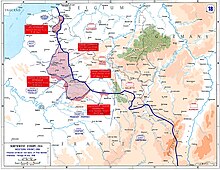Georges Painvin
Georges Jean Painvin (born January 28, 1886 in Paris ; † January 21, 1980 ibid) was a French geologist and successful entrepreneur .
Particularly well known he was but when the cryptanalyst , the 1918 World War I the ADFGX- and ADFGVX encryption broken has that by the Germans during their spring offensive , was used to her using the Morse - wireless technology to keep wirelessly transmitted military messages and commands secret .
It was probably due to Painvin's decipherments that the German troops failed to achieve a decisive breakthrough and to advance as far as Paris. This can be seen from the statements of some well-known authors: “It is thanks to Painvin's work that the spearhead of this attack could be located between Compiègne and Montdidier, both 80 km north of Paris.” “His achievement had a landslide for further decoding Result, including that of a radio message with the command »Immediate ammunition delivery. Even during the day, if not observed. "[...] The urgent need for ammunition suggested that this was the place where the German attack threatened, which was confirmed by the aerial reconnaissance. The Allies sent troops to reinforce the section of the front, and a week later the German attack began. The German troops had lost the element of surprise and were thrown back in a hellish battle that lasted five days. "The cryptologist and former director of the Max Planck Institute for Astrophysics in Garching near Munich, Professor Rudolf Kippenhahn , concludes:" It is probably his [ Painvins] It's thanks to German soldiers not walking around the Champs-Élysées during World War I. "
Web links
Individual evidence
- ^ Fred B. Wrixon: Codes, Ciphers & Other Secret Languages. Könemann Verlag, Cologne 2000, p. 75. ISBN 3-8290-3888-7
- ↑ Simon Singh: Secret Messages . Carl Hanser Verlag, Munich 2000, p. 132. ISBN 3-446-19873-3
- ^ Rudolf Kippenhahn: Encrypted messages, secret writing, Enigma and chip card. Rowohlt, Reinbek bei Hamburg 1999, p. 193. ISBN 3-499-60807-3
| personal data | |
|---|---|
| SURNAME | Painvin, Georges |
| ALTERNATIVE NAMES | Painvin, Georges Jean (full name) |
| BRIEF DESCRIPTION | French geologist and entrepreneur |
| DATE OF BIRTH | January 28, 1886 |
| PLACE OF BIRTH | Paris |
| DATE OF DEATH | January 21, 1980 |
| Place of death | Paris |
